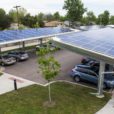**Update: This bill (S.2995) was vetoed by the Governor on 1/14/21. It was then re-filed (with the exact same bill text) on 1/19/21 as S.9. It was passed again by the Senate and House on 1/28/21 and sent back to the Governor, who has 10-days to sign or veto it. [For updates: subscribe to Climate XChange’s MA Newsletter]
In Massachusetts, lawmakers on Monday (1/4) rapidly unveiled and passed a 57 page climate bill (S.2995) heralded by its negotiators as “the strongest effort of its kind in the country.” The bill now sits on the Governor’s desk, where its future is uncertain.
In a pleasant surprise for climate activists, the final bill released was notably ambitious, allaying concerns that the 151 days of conference committee negotiations would yield a heavily watered-down compromise.
The bill takes a number of ambitious steps to tackle climate change, with some of the biggest wins in environmental justice, creation of a new local net zero stretch code, boosts to the state’s emissions reductions goals, and the creation of new sector-by-sector sublimits on emissions. [see the full bill summary below]
HOW WE GOT HERE
This bill (S.2995 – An Act creating a next-generation roadmap for Massachusetts climate policy) is the culmination of multiple climate policy efforts, with both the Massachusetts House and the Senate passing their own comprehensive climate bills over the past year. When it comes to climate policy, comprehensive legislation is becoming the norm rather than the exception in Massachusetts, with such legislation passed in 2016 and 2018. Part of this is due to the intense political pressure facing lawmakers to act on climate change; fueled by dedicated activists, the increasingly real local damage caused by climate change, and the need to support the state’s growing clean energy industry. Another factor driving the preference for comprehensive climate legislation is the sheer complexity of the issue, with the average bill containing over a hundred sections covering multiple different sectors, technologies, and emissions reduction approaches.
It was not surprising then when the Senate released its ‘Next Generation’ package of climate bills in January 2020 (earlier than usual for such legislation). Led by Sen Michael Barrett (D-Lexington) and passing with overwhelming bipartisan support, key features of the bill included an economy-wide carbon price and a requirement that the state reach net zero emissions by 2050. The bill also included a number of other key provisions targeting emissions in every economic sector — like local net zero stretch codes, utility reform, new climate policy oversight, appliance efficiency standards, and transportation electrification.
Meanwhile, in July 2020 the Massachusetts House passed its own climate bill (H.4933) by similar margins. Based in part on the 2050 Roadmap bill filed by sophomore Rep Joan Meschino (D-Hull) and bills filed by Rep Thomas Golden (D-Lowell), Rep Patricia Haddad (D-Somerset), and others, it included changes to the state’s emissions targets and largely emphasized policies to decarbonize the electric sector like grid modernization, solar net metering, offshore wind, and municipal light plants. Notably, the House bill also included an update to the state’s definition of environmental justice (EJ), along with new siting approval requirements that benefit EJ communities, that had been pushed by a coalition of lawmakers, environmentalists, and community groups.
After each chamber passed their respective bill, lawmakers established a conference committee to negotiate the differences between them. The committee was led by Rep Golden and Sen Barrett (the co-chairs of the Joint Committee on Telecommunication, Utilities, and Energy), and included Rep Haddad, Sen Creem (D-Newton), Sen O’Connor (R-Weymouth), and Rep Jones (R-North Reading). The committee formed and started negotiating its bill on August 5th, 2020, and released its compromise language 151 days later on January 3rd, 2021. The unusual delay can be attributed to multiple factors, chief among them the more urgent need for legislation relating to the pandemic’s impact on public health, the current economic crisis, and other big issues like police reform. In general, legislative leaders signaled throughout the session that climate was important but that it would come last in the legislative calendar. Another factor to the delay was the complexity of the negotiations, with each chamber’s bill focused on a different set of climate solutions and to varied degrees of intensity.
In the end, the bill that was released by negotiators (S.2995) passed with overwhelming support on January 4th, 2021 in the Senate (38 for, 2 against) and the House (145 for, 9 against). The final bill represents a number of compromises, with the Senate getting the tougher emission limits it sought and the House getting its offshore wind and environmental justice priorities.
NEXT STEPS
The bill is now before Governor Charlie Baker (R), who has 10-days (until January 14th, 2021) to sign or veto it. It’s uncertain what he will do. After releasing the bill, Senator Barrett expressed that it could be vetoed, and urged supporters to contact the Governor. No statement has been made by the Governor at this time. One potential sticking point is that the 2030 emissions goal outlined in the bill is more ambitious than the goal the executive branch hinted to last week. The legislature wants a 50% reduction by 2030, while administrative representatives said they prefer a 45% emissions reduction. Since the legislative session officially ends today (1/5), the legislature has no opportunity to override a veto, and would have to file and vote on the bill again in the new session that starts on January 6th.
Even if the bill is signed into law, there remain a number of major issues that will need to be addressed in the next session that aren’t included in this bill. Among them:
Fully funding a green recovery and local clean investment
The bill doesn’t include substantial new revenue for state-wide or local investment in clean transportation, electrification, or home heating retrofits, aspects included in the unpassed 2019 GreenWorks bill from the House or Rep Driscoll’s (D-Milton) green recovery amendment to the 2020 economic development bill.
Further efforts on environmental justice
The EJ language in the final bill is a major win for advocates and community leaders, but it’s not the end of the fight to achieve environmental justice in the state. Other measures, like pollution control districts and money for frontline and historically disadvantaged communities, will be a priority going forward.
Closing the biomass loophole
Despite provisions in the final bill that make biomass ineligible for renewable energy incentives, the bill will not cause the controversial Springfield biomass incinerator to be shut down, a priority for activists over the past months.
Eliminating the ‘carbon pricing gap’
Currently emissions from electricity and (soon) transportation are covered by a price on carbon in Massachusetts, generating revenue to boost the green economy and invest in clean transportation. This leaves emissions from buildings untouched, which represent 35% of overall state emissions.
Achieving 100% renewable energy
The final bill does accelerate the state’s adoption of renewables, and only ensures 40% of electricity is renewable by 2030. This is far short of the goal of 100% renewables by 2035 pushed by Environment Massachusetts, Rep Decker (D-Cambridge) and the Mass Power Forward coalition.
BILL SUMMARY
Read its full text and track the bill’s progress here: S.2995 – An Act creating a next-generation roadmap for Massachusetts climate policy. [After each summary point you can find the sections of the bill relating to it.]
SETTING STATEWIDE CLIMATE POLICY
Establishes aggressive 5 year emissions limits
Changes state law to require Massachusetts to set emissions targets (known as ‘limits’) every five years (as opposed to every ten), which bill drafters say “keeps our attention riveted on the climate.” Also requires the Governor to create and release “comprehensive, clear, and specific” plans and reports, known as ‘roadmaps’, that outline how the state will meet each emissions limit. The administration is also required to establish regulations to achieve the policies outlined in each roadmap. (Section 10)
First sector-by-sector sublimits in the nation
Massachusetts will become the first state to adopt “emissions sublimits.” This means that in addition to having economy-wide emissions limits, the state will also require further emissions reductions in six “high-priority” sectors of the economy: electric power, transportation, commercial and industrial heating and cooling, residential heating and cooling, industrial processes, and natural gas distribution and service. (Sections 9, 106-111)
Benchmarks clean technology adoption
Requires the state to set numerical benchmarks for the adoption of electric vehicles, charging stations, solar technology, energy storage, heat pumps, anaerobic digesters, and other clean technology solutions. These are required to align with new limits and sublimits. (Section 10)
Establishes net zero emissions goals for 2050
Makes legally binding the statewide greenhouse gas limit for 2050 at net zero, as opposed to the previous target of 85% reductions by 2050. The Baker administration has already set a goal for net zero by 2050, but it could (hypothetically) be reversed by a future Governor if it is not added into state law. (Section 8)
Requires 50% reductions by 2030
More ambitious than the 45% reductions advocated by Governor Baker’s administration. The bill also requires 75% reductions by 2040. (Section 8)
Requires municipal light plants (MLPs) to reduce emissions
For the first time, requires MLPs to meet emissions standards, requiring them to purchase 50% non-emitting electricity by 2030 and get to “net zero” emissions by 2050. MLPs are electric utilities operated by a specific city or town, and collectively account for 14% of the state’s energy. (Sections 33, 34, 102)
CLIMATE JUSTICE
Codifying environmental justice
For the first time, writes environmental justice into Massachusetts law by defining environmental justice populations and providing new tools, protections, and public input for frontline communities. (Sections 55-60) Also requires that each roadmap plan to explicitly include ways the state can improve or mitigate economic, environmental, and public health impacts on environmental justice populations and low and moderate income individuals. (Sections 10, 57)
Removes incentives for biomass
For five years, it prevents wood-to-energy (aka. ‘biomass’) from qualifying for renewable energy incentives. Also requires the administration to conduct a new study of the impact of biomass on greenhouse gas emissions and public health. There was some confusion over whether this would stop operation of the controversial Springfield biomass facilitator, but reporting from WBUR’s Miriam Wasser showed that it would not. (Section 33, 34, 112)
HEATING & BUILDING EMISSIONS
Allows towns to adopt local net zero stretch codes
Mandates the administration to create a local net zero stretch energy code that municipalities would have the option to opt-in. This is a crucial step in decarbonizing new buildings, which if built inefficiently ‘lock in’ emissions for the lifetime of the building. According to bill drafters, it also allows for cities to adopt local bans on new fossil fuel construction. Brookline attempted this, passing an ordinance in 2019, that was eventually struck down by Attorney General Healey after she ruled it was illegal without a new state law. (Sections 31, 101)
Reforms building regulation board
Adds four new seats to the Board of Building Regulations and Standards (BBRS) for experts in building energy efficiency, advanced building technology, and the Commissioner of the Department of Energy Resources (DOER). Also transfers responsibility for energy code development to the DOER and away from the BBRS. (Sections 64-74)
ENERGY EFFICIENCY
Aligns MassSave with climate policy goals
Requires each three-year MassSave plan to report on emissions reductions actually achieved and to include an explicit value for greenhouse gas reductions when they calculate the cost-effectiveness of the various MassSave programs. (Sections 16-18, 20-30)
Sets nationally consistent appliance efficiency standards
Sets Massachusetts appliance efficiency standards according to precedents set in California and likely future federal standards. This will help drive down emissions from common household and commercial appliances, and may save residents, businesses, and local and state governments more than $287 million annually by 2035. This also includes certain water-saving technology relating to plumbing fixtures and sprinklers. (Sections 35-55, 113)
CLEAN ENERGY
Increases offshore wind development by 43%
Boosts the amount of offshore wind utilities are required to purchase by an additional 2,400 megawatts. This builds upon previous legislation and will result in a total authorization to 5,600 megawatts of offshore wind for Massachusetts. It also gives the administration the power to require offshore wind developers to coordinate on building offshore wind energy transmission lines to the mainland. The bill also quickens the timeframe for procuring new offshore wind by 6 months. (Sections 91-93, 95)
Boosts renewable portfolio standard (RPS)
Raises the Renewable Energy Portfolio Standard (RPS) by 3% each year for 2025-2029, which would ensure at least 40% of the state’s electric power will come from renewables by 2030. (Section 32)
Seeks to increase solar access & equity
Forces the administration to prioritize low-income communities in the SMART, the state’s primary solar incentive program (Section 94). Also allows low-income individuals to enroll in solar “without signing complicated contracts” (Section 96), and establishes a new solar energy grant program for nonprofits working to address food insecurity and homelessness (Section 54).
Includes a number of updates to the state’s solar laws
Loosens the current net metering caps by allowing an owner of a new solar project to give solar credits to customers regardless of where in the state they live (Section 84). Also includes what bill writers called “a long-awaited compromise between local tax assessors and developers on the tax status of clean energy installations.” (Sections 61, 97, 98, 105) It also enables small municipal buildings to have rooftop solar net metered (Sections 82, 83), makes it easier for some businesses and other large customers to install solar (Section 85), and lets utilities own some solar projects. (Section 77)
UTILITY REFORMS
Incorporates climate into DPU mandate
For the first time, statutorily enacts a mandate for the Department of Public Utilities (DPU), the state’s regulator of electric and natural gas utilities. Going forward, the DPU would be required to balance priorities for system safety, system security, reliability, affordability, equity, and, significantly, reductions in greenhouse gas emissions. (Section 15)
Puts $12 million towards workforce development & jobs
Gives the Massachusetts Clean Energy Center (MassCEC) $12 million in new annual funding for clean energy workforce development for minority and women owned small businesses, environmental justice communities, and fossil fuel workers. The program would provide educational and professional development, job placement, startup opportunities, and grants to participants. (Sections 14, 19)
Reform to natural gas safety standards & fines
Finally passes legislation updating the gas safety regime, a legislative priority since the 2018 Merrimack Valley gas explosions. Includes new regulations certifying utility contractors; (Section 103), creates standards for maintaining gas distribution maps and records (Section 86), and extends whistleblower protections to utility employees (Sections 75, 76). It also doubles the penalty for failure to restore service after emergencies to $500,000 per violation day (Section 790 and establishes an increased maximum penalty of $50 million for failure to meet emergency preparation and service restoration standards (Section 80). It also requires the state to investigate and publish all written gas service complaints (Section 78) and sets interim targets requiring companies to reduce gas leak rates. (Section 87-88)
OTHER PROVISIONS
Transparency in climate policy development
Mandates transparency with respect to the inputs, outputs, assumptions, and modeling involved in the formulation of state climate policy. (Section 10)
Consideration of natural & working lands
Incorporates within climate policy planning the promotion and protection of natural and working lands, with the goal of increasing carbon sequestration. (Sections 4 & 10)
Allows utilities to pilot renewable thermal technology
Authorizing utilities to pilot renewable thermal energy sources, systems or technologies capable of substituting for fossil-fueled natural gas, including geothermal heating and cooling. Bill sponsors say this “nudges natural gas utilities to get into new lines of work.” (Section 99)
Gives incentives to hydrogen energy and fuel cell technology
Exempts fuel cell systems from local property taxes, which should further reduce the cost of installing hydrogen fuel cell technology. (Section 62)










